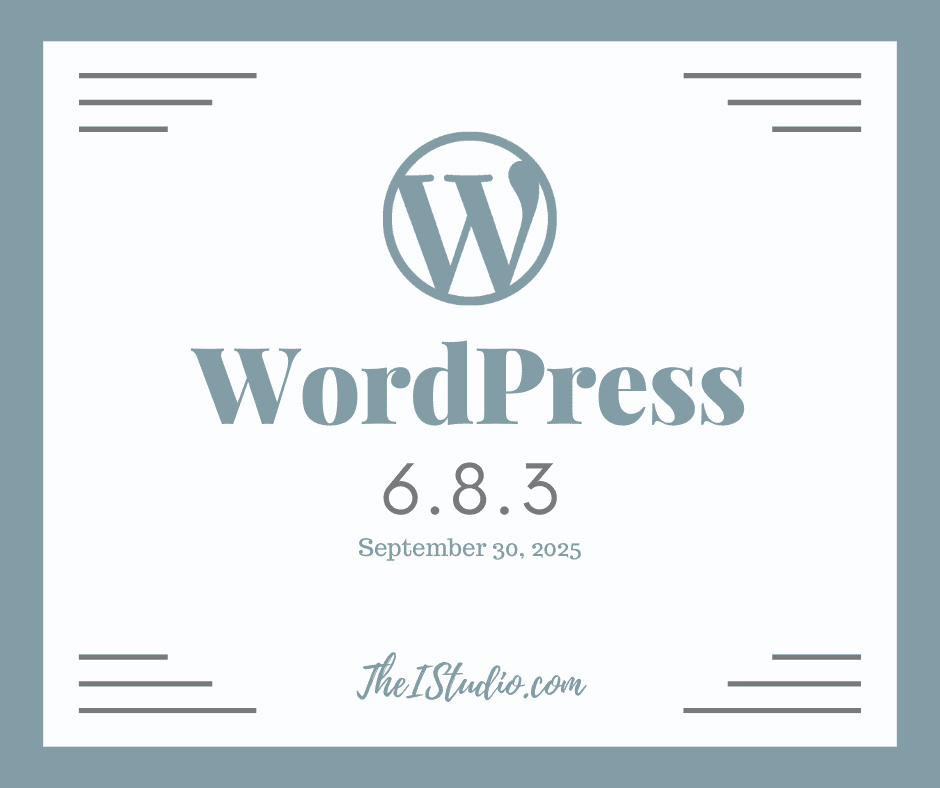How to Update to WordPress 6.8.3 Security Release

This post, updated with each new release, will note any specific recommendations for each. If applicable, I’ll provide additional insight into new features and functionality. I’ll also include some WordPress backup tips, updates, and other recommendations for your consideration.
Bookmark this article (Press Ctrl + D to Bookmark this page) so you can return each time there is a new WordPress release.
WordPress 6.8.3 Security Release
This is a security release that features two fixes.
As this is a security release, we recommend updating your sites immediately.
You can download WordPress 6.8.3 from WordPress.org, or visit your WordPress Dashboard, click “Updates”, and then click “Update Now”. If you have sites that support automatic background updates, the update process will begin automatically.
Security updates included in this release
The security team would like to thank the following people for responsibly reporting vulnerabilities and allowing them to be fixed in this release:
As a courtesy, these fixes have also been made available to all branches eligible to receive security fixes (currently through 4.7). As a reminder, only the most recent version of WordPress is actively supported.
WordPress 6.8.2 Maintenance Release July 15, 2025
This minor release includes fixes for 20 Core tickets and 15 Block Editor issues. For a complete list of bug fixes, please refer to the release candidate announcement.
WordPress 6.8.2 is a short-cycle maintenance release. More maintenance releases may be made available throughout 2025.
If you have sites that support automatic background updates, the update process will begin automatically.
You can download WordPress 6.8.2 from WordPress.org, or visit your WordPress Dashboard, click “Updates”, and then click “Update Now”. For more information on this release, please visit the HelpHub version page.
WordPress 6.8.1 Maintenance Release: April 30, 2025
This minor release includes fixes for 15 bugs throughout Core and the Block Editor, addressing issues affecting multiple areas of WordPress, including the block editor, multisite, and REST API. For a complete list of bug fixes, please refer to the release candidate announcement.
WordPress 6.8 Cecil: April 15, 2025
More than 320 enhancements and fixes, ensuring a stable release for all—a testament to the power and capability of the WordPress open source community.
You can download WordPress 6.8 from WordPress.org, visit your WordPress Dashboard, click “Updates”, and click “Update Now”.
WordPress 6.8 Feature Overview
- Block Editor
- Accessibility
- Internationalization
- Performance
- REST API
- Security
- Miscellaneous Developer Changes
- But wait, there is more!
Where to Learn More
Learn WordPress is a free resource for new and experienced WordPress users. It is stocked with how-to videos on using various WordPress features, interactive workshops for exploring topics in depth, and lesson plans for diving deeper into specific areas of WordPress.
For more information on this release, please visit the WordPress 6.8 Field Guide.
WordPress Hosting Recommendations:
Note: If you are in a legacy environment with only older PHP or MySQL versions, WordPress also works with PHP 7.2.24+ and MySQL 5.5.5+. However, these versions have reached their official End Of Life and may expose your site to security vulnerabilities.
BEFORE UPDATING WORDPRESS
WARNING: The upgrade will impact all files and folders in the main WordPress installation, including all the core files used to run WordPress. If you have made any changes to those files, your changes will be lost.
WordPress Updating Tips
IMPORTANT
A few simple steps can save you some headaches when updating WordPress themes or plugins. First, double-check with theme and plugin developers before updating to ensure they have tested the latest version of WordPress.
You want to review if they have any concerns or comments about your theme and the new version. For example, some theme shops may ask you to delay updating if their testing reveals issues that need to be addressed first.
Your theme developer may advise you to update your theme before updating WordPress. The benefit of using a quality premium theme and plugins means the developer(s) are always on top of this.
If you’re unsure how an update will impact your current website setup, you can run a dry run in your staging area. For more information, check out my article: What’s a Staging Site and Why Do I Need One?
Step-by-Step WordPress Update Instructions
To help you safely and efficiently update to the most recent version of WordPress, check out my article Quick and Easy WordPress Backup Tips.
It is not just WordPress…
Don’t forget to update your plugins as required. With each WordPress update, you’ll see that plugin developers also update their plugins, which you can do with one click. Additionally, you’ll see a notification bar under the plugin name in the plugins area, featuring a link labeled “Update now.”
After an update, you have several options if something is not working as expected.
When it comes to plugins, if the developer is not testing their plugin to work with the latest WordPress version, consider finding another plugin whose developer is up-to-date with these updates.
Always Backup and Update Promptly
Updating should not be ignored or put off. Every update includes security hardening, so hackers always target unmaintained sites.
That said, I generally wait a day or two (if it’s not an emergency security update) to let any bugs that can be discovered once the new version is out in the wild. It is not uncommon to see maintenance releases come shortly after a primary release due to unforeseen issues. Let’s face it: There is no way to test for 100% of the environments and combinations on the millions of WordPress websites.
When you promptly address WordPress updates and stay up to date with premium theme and plugin updates, you are in step with technology and ensure your website is secure, with the best chance of functioning error-free.
At your service,


